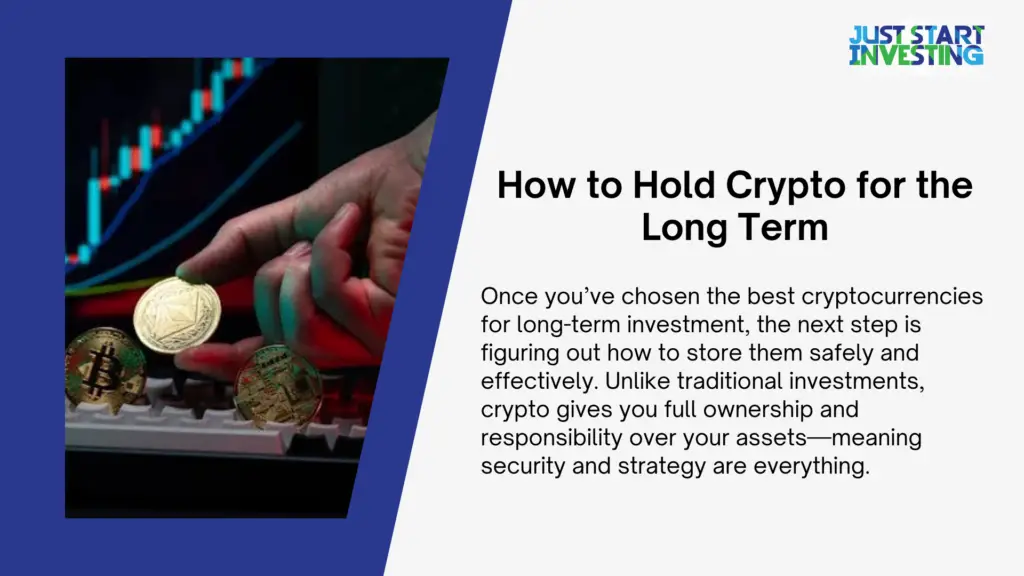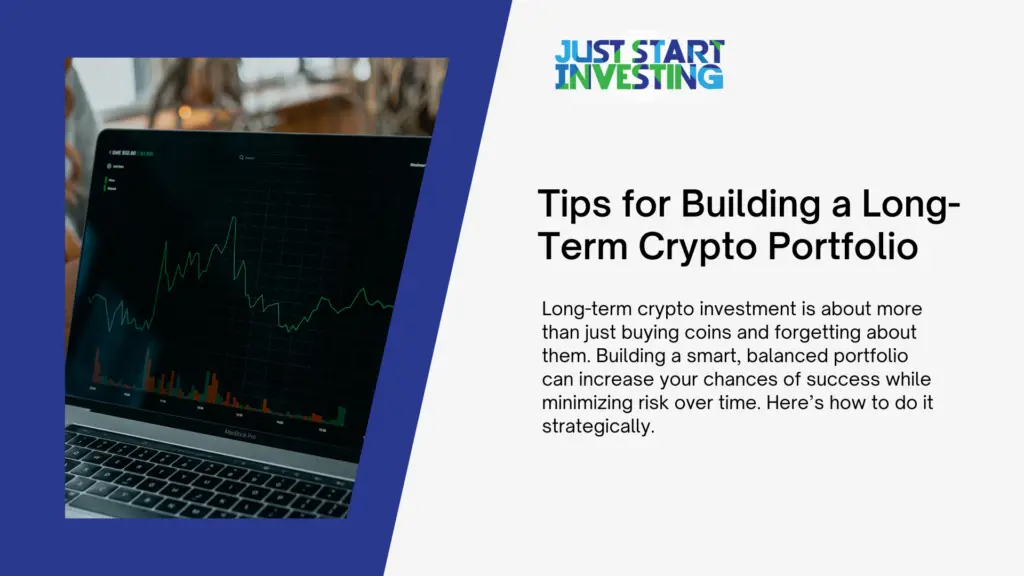Long-term crypto investment is becoming increasingly popular among investors who want to grow their wealth steadily without the pressure of constant trading. With the crypto market maturing and adoption on the rise, more people are choosing to hold digital assets for the long haul—banking on their potential to outperform traditional investments. In this guide, we’ll explore whether long-term crypto investing is worth it, how to choose the right coins, where to store them securely, and how to build a strong portfolio for the future.
What is Long-Term Crypto Investment?
Long-term crypto investment refers to buying and holding cryptocurrency assets for an extended period, often with the expectation that their value will increase significantly over time. This approach contrasts with short-term trading, which focuses on taking advantage of price fluctuations to make quick profits.
Defining Long Term in the Crypto World
In traditional finance, a long-term investment might span 5 to 10 years or more. In the crypto space, however, the market moves rapidly, and even a one-year hold can feel like a lifetime. Generally, long-term crypto investors, often called HODLers, commit to holding their assets for at least one year, and many for much longer—5 years or more—believing in the technology and future adoption of their chosen coins.
Why People Choose Long-Term Over Short-Term
Long-term investing in crypto appeals to those who want to reduce the stress of day-to-day market watching and avoid costly mistakes from emotional trading. By holding through market volatility, long-term investors aim to benefit from the overall upward trajectory of the crypto market, much like early Bitcoin or Ethereum adopters did.
This strategy can also lead to tax advantages in some countries, where holding for over a year results in lower capital gains tax. For many, long-term crypto investment is less about quick wins and more about believing in the transformative potential of blockchain technology over time.
Is Crypto a Good Long-Term Investment?
Cryptocurrency has come a long way from its early days of skepticism and niche adoption. Today, it’s a multi-trillion-dollar industry attracting retail investors, tech innovators, and institutional giants. But the big question remains—is crypto a good long-term investment?
Volatility vs. Long-Term Growth Trends
For newcomers to investing, the sharp swings in the cost of cryptocurrency can be frightening. However, a different picture emerges when one looks past the short-term volatility. Over periods of five or 10 years, major cryptocurrencies like Bitcoin and Ethereum have seen tremendous long-term growth, frequently exceeding traditional assets. Increased acceptance, better infrastructure, and the growing application of blockchain technology across industries are driving these trends.
Although there may be significant short-term price swings, many analysts think cryptocurrency is still in its infancy. The market is anticipated to grow as more practical uses appear and regulatory clarity increases, which could result in longer-term returns that are more consistent.
Comparing Crypto to Traditional Long-Term Assets
Crypto offers distinct advantages—and risks—in contrast to stocks, real estate, or precious metals. It has no borders, runs around the clock, and is not governed by a centralized authority or government. This makes it a speculative asset with significant upside potential as well as an inflation hedge.
It’s crucial to remember that cryptocurrencies don’t have the same track record as conventional assets. Nevertheless, it is a strong choice for portfolio diversification over the long run due to its quick expansion, technological potential, and growing mainstream inclusion.
Tax Benefits and Risks to Consider
In many countries, holding crypto for longer than a year can reduce your capital gains tax rate, just like with traditional investments. This tax benefit is one more reason why many investors choose to buy and hold rather than trade frequently.
That said, crypto is still a relatively new asset class, and its regulatory landscape continues to evolve. Investors should stay informed about local tax laws, secure their assets properly, and be prepared for both upside and downside risks.
Best Cryptos for Long-Term Investment
Not all cryptocurrencies are built the same. While thousands of tokens exist, only a handful demonstrate the technology, utility, and adoption potential needed to survive and thrive in the long run. So, if you’re considering a long-term crypto investment, choosing the right assets is key.
Top Cryptocurrencies to Consider for Long-Term Holding
Here are some of the most promising cryptos to include in a long-term portfolio, based on historical performance, developer activity, and real-world use cases:
- Bitcoin (BTC) – Often called “digital gold,” Bitcoin is the original cryptocurrency and remains the most widely adopted. Its limited supply and decentralized structure make it a popular store of value.
- Ethereum (ETH) – As the backbone of decentralized finance (DeFi) and smart contracts, Ethereum has built a massive ecosystem. With ongoing upgrades to improve scalability and reduce fees, it remains a solid long-term play.
- Solana (SOL) – Known for its high speed and low fees, Solana supports a rapidly growing number of decentralized apps and NFTs. Its tech and developer community give it strong long-term potential.
- Chainlink (LINK) – Chainlink is the leading decentralized oracle network, enabling smart contracts to interact with real-world data. Its unique function gives it a critical role in the blockchain ecosystem.
- Avalanche (AVAX) – Avalanche boasts fast transaction speeds, low costs, and high scalability, making it a serious competitor in the smart contract space.
How to Evaluate Crypto for Long-Term Potential
Before adding any crypto to your long-term portfolio, look beyond hype and headlines. Consider the following factors:
- Market Cap and Liquidity: Larger market caps often indicate stability and mainstream interest.
- Real Utility: Is the project solving a real problem? Does it have active users and applications?
- Developer Activity: A strong development team and frequent code updates signal long-term viability.
- Community Support: An engaged community often helps sustain momentum and adoption.
- Roadmap and Partnerships: Look for clear goals and credible partnerships that support long-term growth.
By evaluating these elements, you can identify cryptocurrencies that are more likely to stand the test of time—and avoid those that may fizzle out after the hype fades.
How to Hold Crypto for the Long Term

Once you’ve chosen the best cryptocurrencies for long-term investment, the next step is figuring out how to store them safely and effectively. Unlike traditional investments, crypto gives you full ownership and responsibility over your assets—meaning security and strategy are everything.
Choosing the Right Storage Method
There are several ways to hold crypto, but not all are suited for long-term investing:
- Hardware Wallets: These physical devices (like Ledger or Trezor) store your crypto offline, making them immune to online hacks. They’re widely considered the most secure option for long-term holders.
- Software Wallets: Installed on your desktop or mobile device, software wallets like MetaMask or Trust Wallet offer flexibility and convenience. However, they’re more vulnerable to malware and phishing attacks.
- Custodial Wallets: If you use exchanges like Coinbase or Binance, your crypto is stored in a custodial wallet. While convenient, you don’t truly “own” your private keys, meaning your access could be restricted in certain situations.
For long-term holding, hardware wallets or secure software wallets with strong backup practices are usually the safest choices.
How to Reduce Risk While Holding
Holding crypto long-term doesn’t mean you can ignore risk management. Here are key tips to protect your investment:
- Diversify Your Holdings: Don’t put all your funds into one coin. Spread across different assets and sectors to balance potential returns and risk.
- Use Strong Security Practices: Enable two-factor authentication, use strong and unique passwords, and keep backup seed phrases offline and secured in multiple places.
- Stay Informed: Keep an eye on project updates, market changes, and security vulnerabilities. Even long-term holders should check in occasionally to ensure their strategy is still sound.
By securing your assets and maintaining a simple, consistent approach, you can let your investments work quietly in the background—without the stress of daily price tracking.
Where is the Best Place to Hold Crypto
Storing crypto long-term isn’t just about how you hold it—it’s also about where. Choosing the right place to store your digital assets can make a major difference in terms of security, accessibility, and peace of mind.
Top Wallet Recommendations for Long-Term Investors
If you’re serious about long-term crypto investment, the following wallet types and providers are among the most trusted in the space:
- Ledger Nano X: A leading hardware wallet that stores your private keys offline. It’s compact, highly secure, and supports a wide range of cryptocurrencies.
- Trezor Model T: Another highly secure hardware wallet, known for its transparency and open-source firmware.
- MetaMask: A popular software wallet that works well with Ethereum and ERC-20 tokens. While convenient for web interactions, it’s best used with extra security measures.
- Exodus Wallet: A user-friendly desktop and mobile wallet that supports many assets. It offers a built-in exchange but is less secure than hardware options for long-term holding.
- Coinbase Vault: For those who prefer custodial options, Coinbase Vault adds extra layers of security, including time-delayed withdrawals and multi-approval steps.
Should You Use a Crypto Bank or Custodian?
Crypto custodians and banks offer managed storage solutions, appealing to those who want convenience and professional-grade security. These services are often used by institutions and high-net-worth individuals.
Pros:
- Easier to manage large portfolios
- Insurance and recovery options
- Built-in compliance and tax reporting
Cons:
- You don’t hold your private keys
- Subject to regulations, platform policies, and potential freezes
- Less control over your assets
The rule of thumb: If you don’t hold your keys, you don’t fully own your crypto. For most long-term investors, hardware wallets provide the best balance of control and safety.
Which Crypto Has the Most Potential
When thinking long term, many investors ask the same question—which cryptocurrency will grow the most in the next five years? While no one can predict the future with certainty, analyzing key factors can help identify coins with strong long-term potential.
Factors That Influence Long-Term Potential
Here’s what to look for when evaluating a cryptocurrency’s five-year outlook:
- Technology and Scalability: Projects that solve real problems with innovative tech (like Ethereum’s smart contracts or Solana’s high-speed architecture) are more likely to stick around.
- Ecosystem Growth: A vibrant community of developers, dApps, and integrations signals ongoing utility and user demand.
- Regulatory Resilience: Coins with transparent governance and a track record of regulatory compliance are better positioned to thrive as crypto matures.
- Partnerships and Institutional Support: Collaborations with major companies or financial institutions add credibility and real-world use cases.
- Security and Network Stability: A history of secure operation and consistent updates shows that a project is being maintained responsibly.
Underrated Coins to Watch
While Bitcoin and Ethereum often steal the spotlight, several emerging projects are quietly gaining momentum. Here are a few to keep an eye on:
- Cosmos (ATOM): Focused on blockchain interoperability, Cosmos enables different blockchains to communicate and share data, which is key for crypto’s future.
- Arbitrum (ARB): A Layer 2 scaling solution for Ethereum, Arbitrum reduces gas fees and increases transaction speed—crucial for mass adoption.
- Near Protocol (NEAR): Built for usability and scalability, NEAR emphasizes a developer-friendly environment and is gaining traction in Web3 applications.
- Polkadot (DOT): With its parachain architecture, Polkadot aims to create a more connected and scalable multi-chain ecosystem.
- Optimism (OP): Another Ethereum Layer 2, Optimism is gaining support for its ability to make dApps faster and cheaper to run.
These projects may not have reached their peak yet but show strong signs of long-term growth based on innovation, adoption, and developer interest.
Tips for Building a Long-Term Crypto Portfolio

Long-term crypto investment is about more than just buying coins and forgetting about them. Building a smart, balanced portfolio can increase your chances of success while minimizing risk over time. Here’s how to do it strategically.
Dollar Cost Averaging Strategy
Dollar-cost averaging (DCA) is one of the most effective techniques for long-term investors. Instead of trying to time the market, you invest a fixed amount on a regular schedule—weekly, monthly, or quarterly.
- Why it works: It reduces the emotional pressure of buying at the “perfect” moment and smooths out volatility over time.
- How to do it: Choose a budget, set your schedule, and automate your buys through an exchange or app.
This method encourages consistency, which is key in crypto markets that can swing wildly from week to week.
Rebalancing and Risk Management
Your portfolio may shift over time as some assets grow and others lag. Rebalancing involves reviewing your holdings and adjusting them back to your original target percentages.
- Example: If Bitcoin was supposed to be 40% of your portfolio but it grows to 60%, you might sell some BTC and reallocate to other assets.
- How often? Some rebalance quarterly, others once a year—it depends on your goals and risk tolerance.
Also, consider setting stop-losses or taking partial profits when an asset reaches a certain gain. While long-term investors typically avoid frequent selling, it’s okay to lock in profits or cut underperformers to stay on track.
Diversification is Your Friend
Don’t put everything into one coin—even if it feels “safe.” Diversifying across different projects, sectors (like DeFi, Layer 1s, oracles), and even risk levels helps protect you from major losses if one project fails.
A well-rounded portfolio might include:
- Large-cap cryptos like BTC and ETH
- Emerging projects with long-term utility
- A stablecoin reserve for flexibility or future buys
Common Mistakes to Avoid in Long-Term Crypto Investing
Even with the best intentions, many long-term investors make simple mistakes that can cost them both money and peace of mind. Here are the most common pitfalls to watch out for—and how to avoid them.
Chasing Hype and Overtrading
One of the biggest traps in crypto is buying into hype-driven coins without doing proper research. Meme coins or “next big thing” tokens might pump in the short term, but they rarely hold value over time.
- Solution: Focus on projects with real-world utility, strong development teams, and long-term roadmaps.
- Tip: Resist the urge to jump into every trending token. Stick to your strategy.
Ignoring Security Best Practices
Crypto gives you control—but also full responsibility. Many investors have lost assets due to hacks, phishing attacks, or lost private keys.
- Solution: Use hardware wallets for long-term storage.
- Always: Back up your recovery phrase in a safe place and never share it online.
- Bonus Tip: Enable two-factor authentication on all accounts.
Not Understanding the Underlying Technology
Investing in a project you don’t understand increases the chance of panic selling during dips—or falling for scams. Blindly following influencers or Reddit threads isn’t a reliable strategy.
- Solution: Take the time to learn the basics of blockchain, how the project works, and what makes it unique.
- Ask yourself: What problem is this crypto solving? Is it actively being developed? Who’s behind it?

